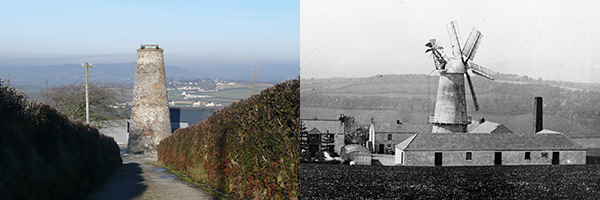Ballindrait Mill
Published in Gems of Architecture, Issue 3 (May/June 2017), Volume 25Murlough, Co. Donegal
By Jon Sass
Near the summit of Croaghan Hill, Murlough, Co. Donegal, are the remains of possibly the most advanced windmill in Ireland. It was built in 1874 by John Sanderson (1819–1901) of Louth, Lincolnshire, for Charles Robinson (d. 1906), farmer, who leased a farmstead and 118 acres from the earl of Erne. Originally called Fir Grove, the property is now known as Windmill Farm.

Above: Ballindrait Mill today and (right) in the early twentieth century. (NIAH; Irish Architectural Archive)
Sanderson was one of England’s premier engineers and millwrights, and his firm is believed to have fitted out two four-sail windmills in Ireland, one of which was Ballindrait Mill; the other is unknown. An old photograph of the mill shows a ball-finial-topped white domed cap and eight-bladed fan, similar to those in two surviving Sanderson mills in Lincolnshire. The sails, a self-regulating system invented in 1807 by Sir William Cubitt (1785–1861) of Norfolk, were standard equipment on all Sanderson-built windmills.
Three pairs of millstones are believed to survive in situ on the third floor at Ballindrait. These would have been driven by the rotating sails through gearing and shafting culminating in a cast-iron horizontal great spur wheel turning timber-toothed pinions. In addition to wind power, steam power from a nearby engine-house was transmitted into the ground floor of the tower.
An article in the Derry Journal described the now-lost equipment in Ballindrait Mill and the uses of the surrounding outbuildings. The mill was
‘… working three pairs of French burr stones … [The windmill can develop] up to 40hp and can be wrought with either steam or wind or with both. It is 60 feet high with seven floors; the engine made by Tennant & Company [of Edinburgh] is horizontal of 10hp and the Cornish boiler is first class, 20 feet long, and 5 feet in diameter with a 3 foot flue.’
The outbuildings included a corn kiln and a flax mill, with ‘a splendid thrashing machine with patent slakers and also a good pulp and hay cutter driven by either steam or wind or both’. The farmhouse, outbuildings and mill could be lit with gas produced on the premises.
The mill was worked until c. 1932. Over the course of its working life the sails were damaged or destroyed during storms on at least three occasions. The cap and sail remains were finally blown off during a storm in the 1960s, and the machinery, other than the millstones, was removed. Local enthusiasts attempted to raise interest in restoration in the 1970s, but without success.
Today the gently tapering tower survives as a monument to the nineteenth-century industrial heritage of County Donegal and Ireland. The seven-storey structure of coursed rubble fieldstone, originally lime-rendered, features a rusticated panel at its midway point perpetuating the memory of its builder, Charles Robinson, with a masonic symbol and the date of construction. The windows on each floor are missing their fittings and, open to the elements, the timberwork within the tower is at risk of collapsing if conservation is not undertaken soon.
Jon Sass is chairman of the Lincolnshire Mill Group. Series based on the NIAH’s ‘building of the month’, www.buildingsofireland.com.
















